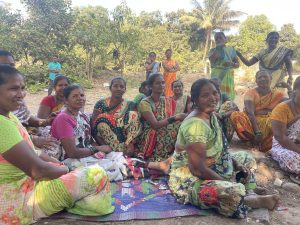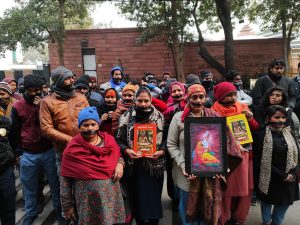Maratha Women’s Voices Missing In Public Discourse Around Reservation
Even the women who are leading pro-reservation rallies in Maharashtra are using the language of patriarchy
- Priyanka Tupe

For the last 70 days Maharashtra has been hit by protests by the Maratha community which is demanding a 13% reservation in jobs and 12% in education as per the recent recommendation of the backward class commission. Protestors have blocked several roads and highways and in many instances turned violent and in turn, the state government has cancelled buses and imposed internet shutdowns to prevent the mobilisation of the streets.
The agitation for the reservation, even though three decades old, is currently being led by Manoj Jarange-Patil, who after a nine day fast-unto-death, has given a 2 month deadline to the government to resolve the issue last evening.
Missing in the leadership of these protests are the voices and representation of women, even though they have been at the forefront of this agitation in several districts across Maharashtra. Women across Beed, Parbhani, Jalna, Chhatrapati Sambhaji Nagar (formerly Aurangabad), Nanded, Pune, Satara, Solapur, Sangli districts are out on the streets demanding reservation. Travelling in shared vehicles to protest sites, carrying bhaji-bhakri (curry and flatbread), they are often joined in large numbers by young women from schools and colleges.
“This is historic. Women who never stepped out of their homes are now mobilising for candlelight marches in villages across the state. The agitation has paved the way for women’s mobility in public spaces. Young girls and children are participating voluntarily because there are no job opportunities for us and education has become costly for the working-class Maratha community,” said Pooja More from Beed who is a Maratha andolak (activist).
In Nanded, three women are on indefinite hunger strike and in 243 villages of the district women have been participating in symbolic, one-day hunger strikes and candle marches in solidarity. They have also been taking an oath to not let politicians into their villages till demands are met, activists told Behanbox. An 18 years old woman, Aarti Shinde, died by suicide, resulting from anxiety.
The Maratha reservation agitation has its origins in the people’s protest after the Kopardi gang rape case of a minor girl in Ahmadnagar in 2016. This soon turned into Maratha Kranti Morcha under the Sakal Maratha Samaj, an umbrella body of Maratha groups and organisations.
“Women’s participation in those protests were as significant as they are now but the Marathi mainstream media is not giving any space to women’s voices this time as they did then,” said Suchita Jogdand, an activist from Marathwada. Other activists we interviewed echoed similar sentiments. A Behanbox analysis of prime time coverage and debate shows of four prominent Marathi news channels on the subject — ABP Maza, Pudhari, Lokshahi and Saam TV – showed that there were no voices of women protestors or analysts.
“The media plays a key role in narrative building but currently the narrative is driven by emotions. Mainstream media has no space for women because they are not represented in the leadership of the Sakal Maratha Samaj (the umbrella body of maratha organisations) this time. Even the many government committees and commissions that were formed after the agitations in 2015-16 don’t have women’s representation,” said Shital Pawar, the executive editor of Sakal, the newspaper.
Maratha Reservation Demand
The Maratha community, categorised as general category is a dominant community historically, politically, socially and economically, comprising one-third of the state’s population, per the 1931 Census report. Labour sociologist Sumeet Mhaskar, in an article published in the Economic and Political Weekly, writes: “As for income patterns, Marathas together with Bramhins and OUCs (Other Upper Castes) have a higher share among the rich and wealthy in rural and urban areas. Marathas have the lowest population of poor people even in rural areas as compared to Brahmins and other upper castes.”
Data show that 30.09% of Marathas fall under the poorest and poor category, compared to 50.27% of Other Backward Castes (OBC), 47.01 % Scheduled Castes (SC) and 62.3 % Scheduled Tribes (ST). Up to 42.41 % of Muslims and 47.76 % of other religious minorities fall under similar income distribution, according to the paper.
“In terms of educational attainment, there is a shared pattern among Bramhins, other upper castes and Marathas. It is only in comparison to Bramhins and OUCs, Maratha lag in educational attainment in higher education. However compared to OBC, SC, ST and Muslims – Marathas are better placed in education,” writes Mhaskar.
In the latest round of the agitation spearheaded by Manoj Jarange-Patil, Marathas are demanding that they be categorised as Kunbis who are classified as OBC. Patil claims that reservation is needed for the ‘garajwant (needy)’, mostly those belonging to the working class (agricultural occupations). He claims that Marathas are Kunbis historically, but were not included in OBC reservations at that time. On the other hand some Maratha activists said they need reservations because of low landholdings, the growing agrarian crisis and high levels of youth unemployment
After 58 mook morchas (silent protests) in 2016 demanding a quota for the Marathas, the state government ordered the State’s Backward Classes Commission to assess the socio-economic status of the community and make recommendations. A commission, headed by MG Gaikwad, was set up and it submitted its report to the government in 2018. The report also said that most members of the Maratha community have fewer landholdings, that 98% Marathas own less than 2.5 acres of agricultural land and hence, are marginal farmers.
The commission recommended 13% quota in jobs and 12% in education for Marathas, as we said earlier. After this, the Devendra Fadanvis government declared a 16% quota for Marathas through an ordinance. This was subsequently challenged in Bombay High court and the Supreme Court by Jayashri Patil and others (multiple petitioners.) The Bombay High court upheld the state’s decision which was later struck down by the Supreme Court in May 2021. The Sakal Maratha Samaj expressed anguish at the Maharashtra government’s inability to defend its cause to the Supreme Court.
Why Women Want Reservations
Behanbox spoke to women andolaks from Aurangabad, Kolhapur, Nanded, Beed, and Pune Mumbai to understand their views on reservation. They all emphasised the need for reservations to create opportunities for themselves given the prevailing socio-economic conditions.
“Women will benefit from Maratha reservation as it will create opportunities for them in higher education and jobs, which will enable them to exercise their agency, right from financial decisions to all personal life choices, which they currently lack,” said Nanded activist Suchita Jogdand. “Working class Maratha people marry off girls at a very early age and that results in early and unwanted pregnancies, malnutrition, poor health, maternal deaths and so on.” Jogdand is currently unemployed though she holds a Masters in journalism and mass communication. She is now preparing for competitive exams with the hope of an economically secure future.
“People should look at our women’s situation in Marathwada. Agricultural produce is low because of the drought, there are no jobs, and women can’t manage essentials like food or even menstrual products,” she adds.
Kavita Nanaware, a Kolhapur-based researcher and poet understands the sentiments of Maratha women like Jogdand but is quick to emphasise that the demand for reservation must be seen through a critical lens.
“It’s true that a large section of the Maratha community is struggling with everyday economic hardships and reservation may solve the issue a little. But there are larger structural issues that the community needs to fight for. Agrarian crisis and the lack of a Minimum Support Price to the farmer is one of them. Privatisation, which is killing jobs in the government sector, is another,” said Nanaware.
Jogdanad also feels that these agitations are becoming spaces for women to challenge patriarchal norms. “Matisathi aani lagnasathich garabaher pandarya Maratha mahila aaj gharabaher padu lagalya, gava gavat chowka chowkat basu laglya (Women who only ever went out for funerals and weddings have started stepping out of their homes to protests in public spaces),” she pointed out.
Swati Nakhate-Patil, 32 a lawyer and activist from Chhatrapati Sambhaji Nagar (formerly Aurangabad) has been active in the Maratha Kranti Morcha since 2016 and has participated in 36 protests. “I have taken a maternity break so I am not in the field this time but I extend my in person support to the community in every way possible. But my journey so far in agitations has introduced me to the thoughts of Phule, Shahu (Maharaj), Ambedkar. It has also given me an identity and space,” said Patil.
Nanawane is sceptical how long these freedoms will last for Maratha women. “Today they are getting this freedom to take to the streets because the issue is of caste pride. Would they get it for any other reason or without a reason?” she asked.
She suggested that policy reforms to promote women’s education and allow them free commute in rural areas would have greater transformative potential. “The government should ensure women’s safety, end gender based violence and give them the freedom to choose and pursue education and a career,” she added.
Women Absent In Leadership
Women’s absence in leadership positions in the ongoing agitation is palpable. Swati Nakhate-Patil attributed this to several reasons. For one, she said, the agitation which earlier did not have a face, has found a trustworthy leader in Jarange Patil , especially among women who “consider him their brother”.
“Women are occupied with domestic responsibilities, which consumes most of their time,” she said. “But women across the state are participating in smaller, hyperlocal hunger strikes and candle marches.”
Feminist political analysts have a different view. “The history of any community is essentially dominated by men, hence the ‘pride’ associated with this history always has patriarchal undertones. We notice it in the recent Maratha morchas too,” said Gayatri Lele, a Mumbai-based feminist political analyst.
She recalled a television coverage of a rally where the anchor said: “Women and divyangas (government terminology for the disabled) are leading the morcha.” This smacked of tokenism, she pointed out. “Even when they see women at the forefront [of a rally], they hardly have anything categorical to say for Maratha women and their specific demands,” she said.
Lele also drew attention to the metaphors used by women agitators which were steeped in casteist and patriarchal notions. The women wore a feta (turban), used the expression ‘mard (macho) Marathas‘ in the morcha, and constantly invoked conventional images of womanhood (motherhood, or phrases like aayabahini or women from our families). Slogans like ‘aarkshan amchya hakkacha, nahi kunachya baapacha‘ (Nobody’s father can take away our rightful reservation) are repeated by them without articulating their specific demands, she said.
“What do Maratha women actually want beyond these roles and symbolism, how will reservation benefit them? This is not yet clear and there is no discussion around this in the public domain,” Lele said.
We believe everyone deserves equal access to accurate news. Support from our readers enables us to keep our journalism open and free for everyone, all over the world.




